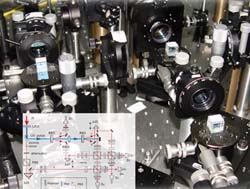
An experimental setup for the demonstration of loss-tolerant quantum codes
Inspired by quantum mechanics, people have been dreaming of a new type of computers to revolutionize computing technique - quantum computers. Such dream machines will take advantage of the fact that the quantum bit (qubit), the fundamental unit of quantum information, can be in a superposition state and thus is able to store massive data and solve complicated problems at an incredible speed beyond the capacity of classical computers. To put this idea into practice, however, scientists are facing many hurdles, notable among which is the problem of qubit loss in quantum computers due to various reasons, including the disturbance from environmental noise.
Recently, a cleverly designed experiment by a group of physicists led by Prof. PAN Jianwei from the University of Science and Technology of China (USTC), CAS, might shed some new light on this seemingly frustrating reality. For the first time ever, the group experimentally demonstrates a method of quantum coding to overcome the qubit loss error, a kind of decoherence especially prevailing in photonic quantum computation (QC). The work was reported in the 12 August issue of
PNAS.
Qubit loss can occur in photon-based QC when for instance, photons are absorbed by the environment or fail to be picked up by a detector. This detrimental effect destroys the information carried by the qubit, introducing errors to the system. Furthermore, qubit loss error can also happen in some multi-level quantum hardware systems, such as those aimed at dealing with the states of multiple particles in ion traps and optical lattice. Theoretically, the states of qubits are defined in a two-level space, whereas in such multi-level systems the state of qubit can leak out to a larger space. In fact, most proposed quantum hardware involves multiple levels; therefore it has become a common issue for physicists to protect the fragile quantum information from loss due to the "leakage", provided that the whole quantum system remaining in the qubit space is the underlying assumption for the QC.
What the USTC team has demonstrated is that by encoding a single-qubit state with four entangled photons using a specially designed network, the logical information could be protected even if any one of the photons is lost. This research is inspired by the early theoretical work of Grassl et al., who in 1997 first proposed a special class of quantum erasure error correction code and proved that a 4-qubit code is sufficient to correct a detected error caused by the loss of one qubit. However, the actual realization of such quantum codes had proved an experimental challenge and was not tackled until 10 years later by the USTC team. It is worth mentioning that the team not only demonstrated the loss-tolerant quantum codes in the conventional quantum circuit model but also in the newly proposed one-way quantum computer model. Their work therefore solves a problem common in many physical systems and is deemed to constitute a necessary step toward scalable quantum information processing.
While optimistic critics are acclaiming the newly achieved progress, the team, however, is cautiously calm. "There are still a lot to do before we can build a practically workable quantum computer. Qubit loss is not the only problem for QC; other types of decoherence are to be overcome," remarks LU Chaoyang, a PhD student with the team. "But good news is, the loss-tolerant quantum codes demonstrated in our work can be further concatenated with other quantum error correction codes or decoherence-free space to tackle multiple decoherence, and may become a useful part for future implementations of quantum algorithms."
The USTC team has been focusing on photonic quantum information processing for some years. Previously, this group achieved a series of breakthroughs, including free-space quantum key distribution over a 13-km free space, five- and six-photon entanglement, demonstration of quantum logic gates and Shor's algorithm. The team is currently expanding their work toward manipulations of larger quantum computers and long-distance quantum communication by combining the technique of quantum memory based on atomic ensembles.





